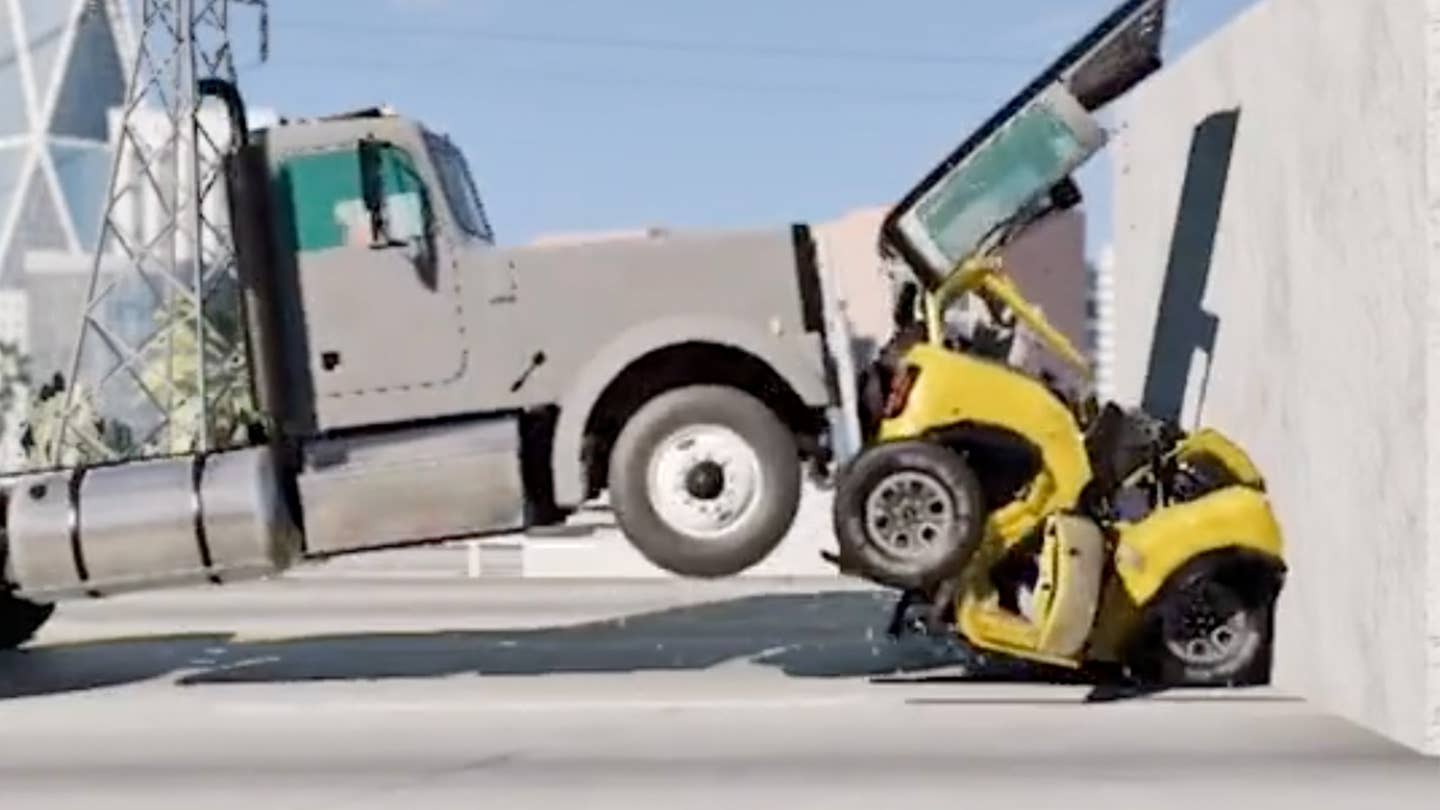No, Those Viral BeamNG Crash Test Videos Aren’t Realistic
These soft-body physics simulations don’t necessarily show how cars would perform in actual crashes.

There's something shocking about seeing a brand-new car crunched up. It's no wonder that people can't get enough of those simulated crash tests from games like BeamNG.Drive. But there's one major problem: Despite the soft-body physics program being highly regarded for virtually recreating intricate crashes, it's not always possible to accurately reproduce real-world results. That's especially true since many of the vehicles used in the game aren't anywhere close to their road-going counterparts. In turn, a lot of the horrific crashes you see in these clips wouldn't look anything like that in reality.
These simulated crash tests can often be seen pitting large vehicles against smaller ones. We're talking about big rigs against tiny sedans, and tests will often increase incrementally in speed as they progress to compare how different forces crumple the cars. For some context, every time you double a vehicle's speed, the force of impact quadruples—that makes for some pretty interesting differences in crash simulations.
Sometimes these tests pit vehicles against poles, giant potholes, jumps, canyons, and in some cases, varying gravity as if they were on other planets. Some of the tested scenarios are ones that can happen every day. Others are ones that likely won't happen, or at least won't be witnessed by people. It's fun to pretend, right?
I'll be the first to admit that the videos are fun to watch. I've caught myself scrolling through TikTok watching these things, prompting the algorithm to serve me more and more BeamNG content. The problem is that some people believe that BeamNG's physics are so true to reality that the vehicles will perform exactly like the video in a crash, every single time.
One of these examples recently popped up on the Bronco6G forum. In particular, one BeamNG-simulated crash test of the new Ford Bronco started making the rounds on TikTok. Users immediately commented on the videos saying the Bronco is "scary" and "the worst." Some went as far as saying that they wouldn't be interested in buying a Bronco after seeing the simulations. And in typical social media fashion, the viral nature of the video led to people seeking more views by attempting to debunk the crash test.
Creating a custom car in BeamNG requires a pretty complex workflow. It's also well-documented by the developers so that the community can mod new vehicles into their games. However, without first-party reference models, measurements, and other details, there is no way for DIY-ers to truly recreate a vehicle's crash structures.
Now, it's exceptionally difficult to simulate a crash test with 100% accuracy in the first place. Those who build the vehicle models would need to know very specific details of each relevant component. This means understanding how parts are constructed, where they are reinforced, where crumple zones exist in the vehicle structure, what material specific parts are made of, any post-manufacturing treatments or curing performed, as well as other OEM-proprietary information that would likely be costly—too costly for a community-modded video game—to reverse engineer. On top of all of that, the physics engine of the simulation software must be accurately tuned as well.
That's not to say that BeamNG's crash physics aren't amazing compared to some other games on the market. In fact, the game's Steam page claims that its crashes feel "visceral" due to its use of "an incredibly accurate damage model." I'll agree with that; they get your attention. After all, they keep me watching video after video, and when compared to some actual real-world tests, I have to admit that some circumstances portrayed by the game are fairly accurate.

All this being said, it's not the first time something on the internet has tricked people. There was that viral Ferrari F40 body kit, a fake Apple Car, a Bugatti Chiron being destroyed by an upset spouse, a TikToker who falsely claimed they were responsible for jumping a Tesla Model S, a V8-swapped Tesla Model 3, and claims of a viral "lug nut challenge" where people are were reportedly loosening lug nuts on cars without the owner's knowledge. Hell, even renders are tricking folks into thinking new versions of their favorite classics are coming every single day.
These crash tests are a lot like the other hoaxes. While the physics engine might make them interesting to watch, they shouldn't be taken as gospel or scientifically tested. And they probably shouldn't influence your buying decisions on cars either. I guess the old adage still applies: don't believe everything you see on the internet.
Got a tip or question for the author? Contact them directly: rob@thedrive.com
